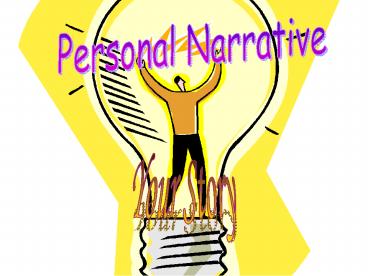Personal Narrative - PowerPoint PPT Presentation
1 / 17
Title:
Personal Narrative
Description:
Title: Personal Narrative Author: swhite Last modified by: CCSD Network User Created Date: 7/28/2003 5:27:41 PM Document presentation format: On-screen Show (4:3) – PowerPoint PPT presentation
Number of Views:909
Avg rating:3.0/5.0
Title: Personal Narrative
1
Personal Narrative
Your Story
2
A Personal Narrative
- Is an interesting story about the writer.
- Is written in the first person (using the
pronouns I, me, and my. - Has a beginning, a middle, and an end.
- Presents events in a clear order.
- Uses details to help readers see people, places,
and events. - Shows how the writer feels about the experience
and why it is meaningful to him or her.
3
The personal narrative tells about
- A good time
- A bad time
- An important time
- A memorable event
- A first time
- A last time
4
Freewrite
- Take a few minutes and write without stopping.
- Write about where the story takes place. Close
your eyes and recall the place in your narrative.
What do you see? Hear? Taste? Smell? Feel? - Write about the people who will be in your
narrative. Think about the way each one looks,
acts, and speaks. Conversation or dialogue is a
good way to draw your readers into the action. - List the main events of the narrative along a
timeline.
5
Writing a Personal Narrative of a Memory
- Lesson 5
- LEQ--How does chronology in a narrative affect
the readers perception of the conflict in the
story?
6
Key Words
- Chronologythe time sequence of the events in a
narrative. - Most of the time, events are told in the
chronological or time order in which they occur. - Sometimes an exciting moment in the chronology
is pulled out as a lead into the introduction to
get the reader interested.
7
Key Words
- Conflictthe problem in the story
- Every narrative needs some kind of problem or
conflict to keep the reader interested. - Try to make your reader aware of the problem or
conflict by the end of your introduction.
8
Review your Planning Page
- Check your skeleton plan
- Remember why you have chose this topic and why it
is important to you.
9
Topic and Tone!
- Choose your topic
- (something that has affected you, taught you a
lesson, inspired you, meant something to you that
is important) - Choose your tone---Humorous or Nostalgic
- Humorousyou help your reader see the funny
side of human nature - Nostalgicyou help your reader understand why
this event in the past meant a lot to you
10
Organizing your Narrative
- Think, Introduction, Development, Conclusion.
- Look at the PSSA Narrative rubric in eBackpack
for helpful reminders about the 9 elements needed
in a good narrative.
11
Lead or Introduction
Grabs the reader's attention!!
Introduces the reader to the situation, .
Introduces the reader to the point of view and
narrator
Introduces the tone and the conflict
12
Types of Leads
- Appeal to the readers senses by writing a vivid
description of the scene. - Make readers wonder by asking a question.
- Lure readers into the story quickly by using
dialogue.
13
Supporting ParagraphsThe Chronology of
events
- Always begin with a transition that helps the
reader understand the progression of time, and
then establish the situation in the topic
sentence. Use specific details that support the
topic sentence. Use sensory words to keep the
readers attention. - Wrap up the paragraph with a concluding or
transitioning sentence. - Remember to develop a minimum of 8 supporting
paragraphs.
14
Transition Words/Phrases for Narrative
Writing After subsequently at first As soon as
first it began Before second it
started Next once after that Initially in
the meantime during
15
Conclusion
- Use a topic sentence for your concluding
paragraph. - Wrap up all loose ends so that the reader doesnt
have any questions. - Your last sentence should conclude the narrative.
The reader knows that the story is over. Giving
a reflection or meaningful insight lets the
reader know how the story events have affected
you and/or the reader.
16
Revise and Edit
- Read your paper aloud to yourself or a partner.
Did the introduction capture you or your
partners attention?. - Is the order of events clear? Did I include
transitions? - Is the tone clearly humorous or nostalgic?
- Do I use details that appeal to the five senses?
- Is the conclusion an end that gives a meaningful
reflection or insight to the narrative? - Do I have at least 10 paragraphs?
17
Have fun writing your narrative!!!































